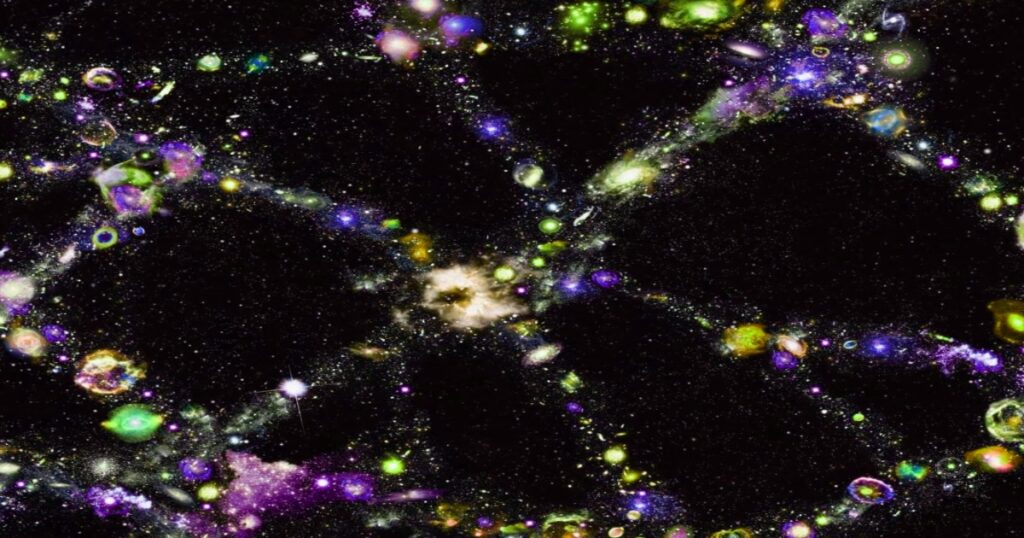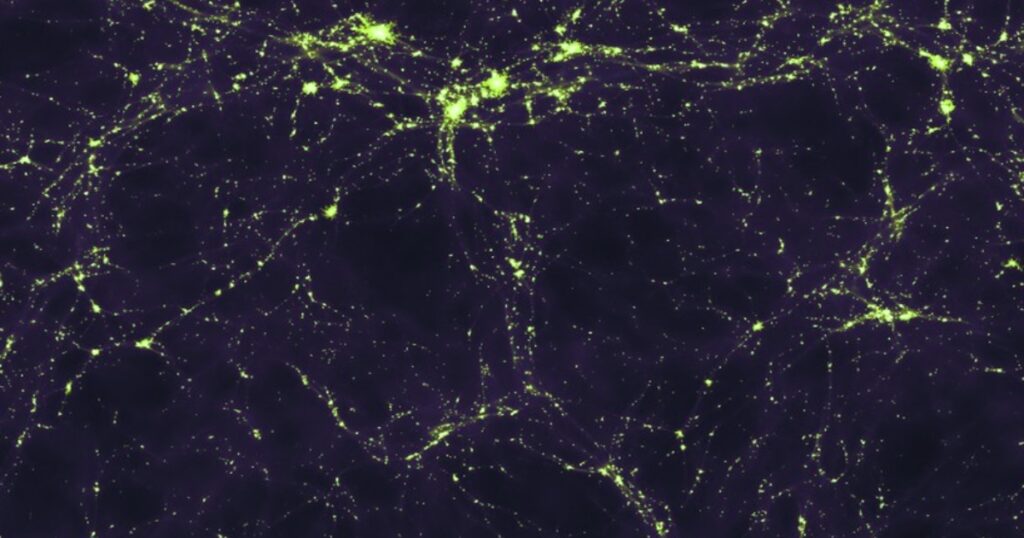BOSS Great Wall Supercluster Complex is one of the largest structures in the universe. The BOSS supercluster complex has a diameter of around 1 billion light years and a total mass of about 10,000 times that of the Milky Way galaxy.
It has at least 830 visible galaxies and many more that are not visible (dark galaxies). Estimates suggest it consists of at least four major superclusters along with several smaller ones. Estimates place the BOSS Great Wall at an average distance of between 4.5 and 6.5 billion light-years from Earth.

Discovery of the BOSS Great Wall Supercluster Complex:
The BOSS Great Wall wasn’t a chance discovery during a stargazing session. It emerged from a meticulous scientific endeavor, the Baryon Oscillation Spectroscopic Survey (BOSS). This international project aimed to map the distribution of galaxies and quasars (incredibly bright objects powered by supermassive black holes) in the early universe.
In 2016, researchers analyzing BOSS data stumbled upon something extraordinary. They identified a colossal conglomeration of superclusters, a filament of galaxies stretching roughly 1 billion light-years across. To put that in perspective, a light-year, the distance light travels in a year, is a mind-boggling 9.5 trillion kilometers.
This discovery pushed the boundaries of what we knew about large-scale structures in the universe.
The Name’s BOSS:
The name BOSS Great Wall is a tribute to the collaborative effort that led to its discovery. BOSS stands for Baryon Oscillation Spectroscopic Survey, highlighting the project that played a pivotal role in its identification.
Baryons are subatomic particles that make up most of the visible matter in the universe, and studying their oscillations provided crucial insights into the large-scale structure of the cosmos.
Spectroscopic surveys, like BOSS, analyze the light emitted by celestial objects. By dissecting this light into its component wavelengths, scientists can glean valuable information about the object’s composition, distance, and movement. This intricate data analysis within the BOSS project revealed the colossal presence of the BOSS Great Wall.
Size of the BOSS Great Wall Supercluster Complex:
The sheer size of the BOSS Great Wall is difficult to grasp. At 1 billion light-years wide, it dwarfs previous contenders for the largest structure title. The Sloan Great Wall, discovered in 2003, pales in comparison with a diameter two-thirds smaller.
Even the Laniakea Supercluster, which encompasses our Milky Way galaxy, seems insignificant next to the BOSS Great Wall’s colossal scale.
Mass of the BOSS Great Wall Supercluster Complex:
The mass of the BOSS Great Wall is equally staggering. Estimates suggest it contains roughly 10,000 times more mass than our Milky Way galaxy. Imagine a cosmic leviathan woven from hundreds of billions of stars, dust, gas, and dark matter, that’s the essence of the BOSS Great Wall.
Immensity of the BOSS Great Wall Supercluster Complex:
This immensity isn’t just about bragging rights. It offers valuable insights into the universe’s formation and evolution. The presence of such a large-scale structure hints at the influence of gravity in shaping the cosmos after the Big Bang.
Studying the BOSS Great Wall allows scientists to piece together the cosmic web, a vast network of filaments and voids that defines the large-scale structure of the universe.
BOSS Great Wall’s Distance from Earth:
Estimates place the BOSS Great Wall at an average distance of between 4.5 and 6.5 billion light-years from Earth.
Structure of the BOSS Great Wall Supercluster Complex:

The BOSS Great Wall isn’t a monolithic structure. It’s a complex tapestry of interwoven superclusters, bound by gravity. Estimates suggest it consists of at least four major superclusters along with several smaller ones, each containing hundreds of individual galaxies.
The two elongated superclusters, aptly named Supercluster A and Supercluster B, are the largest, boasting diameters of 186/h Mpc and 173/h Mpc respectively (h being a factor accounting for uncertainties in the Hubble constant). Superclusters C and D, while still impressive, are moderately sized with diameters of 91/h Mpc and 64/h Mpc.
The presence of these numerous superclusters interwoven within the BOSS Great Wall highlights the immense scale of this structure and the complex interplay of gravity that shaped its formation.
While the exact number of smaller superclusters within the wall is yet to be definitively determined, future observations with advanced telescopes may provide a clearer picture.
Within the BOSS Great Wall, estimates suggest there are at least 830 visible galaxies, with countless others shrouded in the invisible cloak of dark matter.
Dark matter, a mysterious substance that doesn’t interact with light but exerts a gravitational pull, is thought to be the dominant component of the BOSS Great Wall. Visible matter like stars and gas is estimated to constitute only a small fraction of the wall’s total mass.
Understanding the distribution of dark matter within the BOSS Great Wall could shed light on its formation and evolution.
The galaxies within the BOSS Great Wall aren’t static. They are bound by gravity, swirling and interacting with each other in a cosmic dance. Studying these interactions can tell us about galaxy formation and evolution within large-scale structures like the BOSS Great Wall.
The BOSS Great Wall is a crucial component of the cosmic web.
Significance of the BOSS Great Wall Supercluster Complex:
The discovery of the BOSS Great Wall is a significant step forward in our quest to understand the universe. It pushes the boundaries of what we know about large-scale structures and offers a glimpse into the intricate cosmic web. Here are some key takeaways from this discovery:
The universe is vaster than we imagined: The existence of the BOSS Great Wall highlights the immense scale of the universe and the presence of even larger structures waiting to be discovered.
Gravity plays a critical role: The BOSS Great Wall’s existence is a testament to the powerful influence of gravity. Studying its structure helps us understand how gravity shaped the universe after the Big Bang.
The cosmic web takes shape: The BOSS Great Wall is a prominent filament within the cosmic web, a network of interconnected structures throughout the universe. Studying this colossal structure helps us map the cosmic web and understand the large-scale organization of the cosmos.
A window into the past: The immense distance to the BOSS Great Wall (billions of light-years) means we’re observing it as it was billions of years ago. Studying it allows us to peer into the universe’s past and understand its evolution.
Dark matter reigns supreme: The dominance of dark matter within the BOSS Great Wall highlights the need for further research into this mysterious substance. Understanding dark matter distribution will provide insights into the overall structure and evolution of the universe.
The Future of BOSS Great Wall Superstructure Complex Research:
The discovery of the BOSS Great Wall is just the beginning. Astronomers are actively using advanced telescopes and sophisticated computer simulations to delve deeper into its mysteries. Here are some exciting areas of future research:
Mapping the Structure: High-resolution observations with next-generation telescopes can help us create a more detailed map of the BOSS Great Wall, revealing the distribution of galaxies, dark matter, and gas within its vast expanse.
Understanding Galaxy Formation: Studying the interactions between galaxies within the BOSS Great Wall can provide valuable insights into how galaxies form and evolve within large-scale structures.
Probing Dark Matter: By analyzing the gravitational effects on visible matter within the BOSS Great Wall, scientists can attempt to map the distribution of dark matter and understand its properties.
Cosmic Web Connections: Studying the BOSS Great Wall in relation to neighboring structures can help us map the connections within the cosmic web and understand the overall large-scale structure of the universe.
BOSS Great Wall as compared to Sloan Great Wall:
BOSS Great Wall Vs. Sloan Great Wall
| Feature | BOSS Great Wall | Sloan Great Wall |
|---|---|---|
| Type of Structure | Supercluster complex (multiple superclusters bound together by gravity) | Supercluster (a large cluster of galaxies) |
| Size | Approximately 1 billion light-years across | Approximately 400 million light-years across |
| Discovery Year | 2016 | 2003 |
| Significance | Pushed the boundaries of known large-scale structures, offers insights into cosmic web and galaxy formation | Previously held the title of largest structure, significant discovery in understanding large-scale structures |
| Estimated Mass | 10,000 times the mass of the Milky Way galaxy | Less well-defined mass estimate, likely several times the Milky Way |
| Distance from Earth | Between 4.5 and 6.5 billion light-years | Approximately 1.37 billion light-years |
BOSS Great Wall as compared to Laniakea Supercluster:
BOSS Great Wall Vs. Laniakea Supercluster
| Feature | BOSS Great Wall | Laniakea Supercluster |
|---|---|---|
| Type of Structure | Supercluster complex (multiple superclusters bound together by gravity) | Supercluster (a large cluster of galaxies) |
| Size | Approximately 1 billion light-years across | Approximately 500 million light-years across (estimates vary) |
| Discovery Year | 2016 | 2014 |
| Significance | Pushed the boundaries of known large-scale structures, offers insights into cosmic web and galaxy formation | Our home supercluster, crucial for understanding our location in the universe |
| Estimated Mass | 10,000 times the mass of the Milky Way galaxy | Several times the mass of the Milky Way galaxy |
| Contains | Hundreds of billions of stars, dust, gas, and dark matter | Our Milky Way galaxy and at least 100,000 other galaxies |
| Distance from Earth | Between 4.5 and 6.5 billion light-years (observing it as it was billions of years ago) | Milky Way Galaxy is located within Laniakea Supercluster of galaxies |
BOSS Great Wall as compared to Milky Way Galaxy:
BOSS Great Wall Vs. Milky Way Galaxy
| Feature | BOSS Great Wall | Milky Way Galaxy |
|---|---|---|
| Type | Supercluster Complex (multiple superclusters bound by gravity) | Spiral Galaxy (a collection of billions of stars, gas, and dust) |
| Size | Approximately 1 billion light-years across | Approximately 100,000 light-years across (diameter) |
| Mass | Estimated to be 10,000 times the mass of the Milky Way | Contains several hundred billion stars, along with gas and dust |
| Composition | Hundreds of billions of stars, dust, gas, and dark matter | Primarily stars, gas, and dust, with a significant amount of dark matter |
| Structure | Complex network of interconnected superclusters | Flattened disc with spiral arms and a central bulge |
| Location | Between 4.5 and 6.5 billion light-years away from Earth | We reside within one of the spiral arms |
| Significance | Unveiled the vastness of large-scale structures, offers insights into cosmic web and galaxy formation | Our home galaxy, crucial for studying stellar evolution, planetary systems, and potential life |
Conclusion:
The BOSS Great Wall serves as a humbling reminder of the vastness and complexity of the universe. While we’ve taken a giant leap in understanding large-scale structures, the universe continues to hold countless secrets waiting to be unveiled.
As we delve deeper with advanced technology and unwavering curiosity, the BOSS Great Wall will undoubtedly continue to be a focal point in our cosmic exploration.
